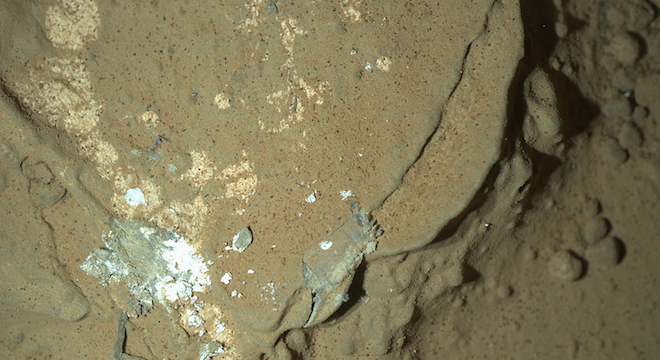NASA’s Mars Curiosity Rover has already captured hundreds of images of the Red Planet’s surface since touching down there last August, but none quite like this: NASA on Thursday published the first images captured at night.
The three images highlighted by NASA were snapped on January 23 using the rover’s Mars Hand Lens Imager (MAHLI) instrument and its accompanying LED and ultraviolet lights.
The MAHLI instrument, which is based upon the same hand lens imagers used by human geologists on Earth, focused on a rock called “Sayunei” for the purposes of this particular engineering test, which was designed to try out imaging capabilities in the dark.
Besides proving a new view of the landscape, the purpose of taking nighttime imagery, and the reason the rover was equipped with the lights necessary to capture it, is to identify any fluorescent minerals in the Martian landscape, NASA explained.
Fluorescence alone isn’t an indicator of what type of mineral the rock may contain, but it can help identify differences between two otherwise similar looking minerals, according to Ken Edgett, principal investor of the MAHLI instrument and senior research scientist at Malin Space Science Systems, San Diego.
“Imagine a rock made up of two minerals that look white, but one fluoresces yellow and the other green… well, that would tell you that there are two different minerals present,” Edgett wrote to TPM in an email.
Here’s a nighttime rover image using its MAHLI instrument’s white LEDs:

And here’s another using UV:

The final image NASA shared was just of a target spot on the rover itself:

Because the data only recently arrived back on Earth, it will be a few more days before the science team can analyze the mineral composition of the rock.
But it is near an area dubbed “Yellowknife,” where NASA plans to use Curiosity’s drill for the first time, in the coming weeks, in a rocky area that was thought to be submerged under water.
Edgett told TPM that it wasn’t until the Curiosity rover entered its current area on the Martian surface almost two months ago that the science team began observing materials that had the potential to fluoresce, or glow, which is partially why they waited so long to snap the nighttime photos.









